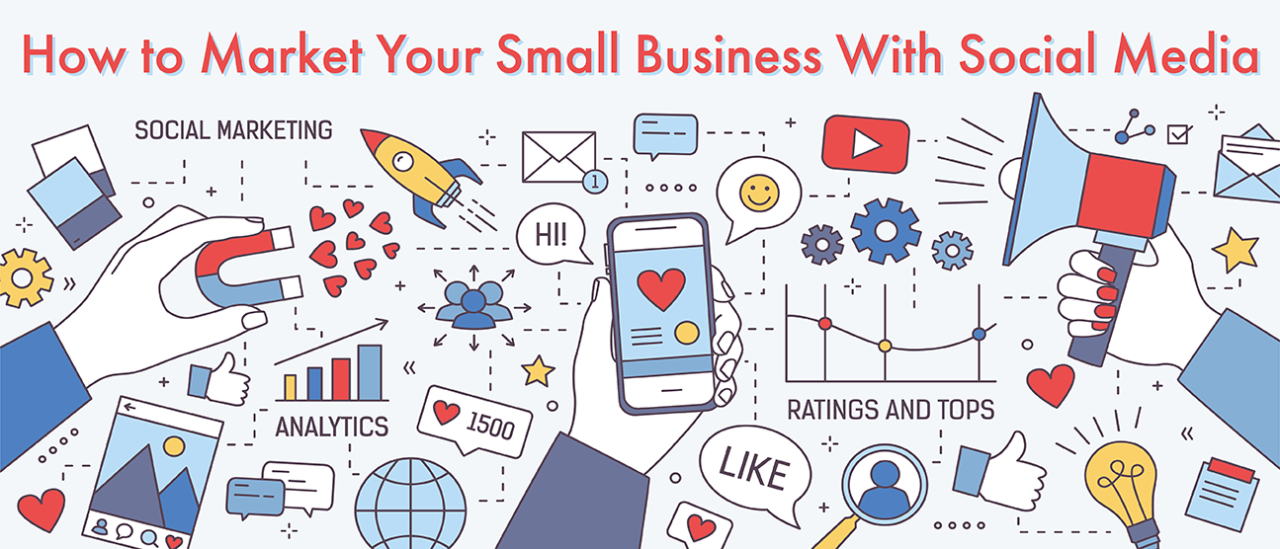How to Market Your Business on Social Media for Small Business
In today’s digital age, social media isn’t just for sharing cat memes and keeping up with friends; it’s a powerful tool that small businesses can use to reach new customers, build brand loyalty, and grow their presence in the market. Social media marketing offers small businesses a cost-effective way to compete with larger companies, allowing for targeted advertising, real-time engagement, and the ability to track and measure success.
Whether you’re just starting out or looking to enhance your current strategy, leveraging social media can give your business the boost it needs. This guide will walk you through the essential steps on how to market your business on social media, ensuring you make the most of every post, tweet, and story. From understanding your audience to creating compelling content and analyzing your results, we’ve got you covered. Let’s dive in and explore how you can harness the power of social media to take your small business to the next level.

What is Social Media Marketing?
Social media marketing is the process of using social media platforms to promote your business, build brand awareness, engage with your audience, and drive sales. It’s about creating and sharing content on social networks to achieve your marketing and branding goals. Social media marketing includes a range of activities, from posting text and image updates to videos, and other content that drives audience engagement, as well as paid social media advertising.

Key Components of Social Media Marketing
- Content Creation and Sharing:
- Types of Content: This includes everything from blog posts, images, and videos to infographics and memes. The goal is to create content that resonates with your audience and encourages them to engage with your brand.
- Consistency: Regular posting keeps your audience engaged and helps to build a loyal following. Using a content calendar can help you plan and maintain a consistent posting schedule.
- Engagement:
- Interaction: Responding to comments, messages, and mentions helps build a relationship with your audience. It shows that you value their input and are attentive to their needs.
- Community Building: Creating a community around your brand can foster loyalty and turn customers into brand advocates. This involves not just posting content, but also participating in conversations and encouraging user-generated content.
- Analytics and Reporting:
- Tracking Performance: Using analytics tools to monitor the performance of your social media efforts is crucial. This includes tracking metrics like engagement, reach, and conversions.
- Adapting Strategies: Analyzing data helps you understand what works and what doesn’t, allowing you to tweak your strategy for better results.
- Paid Advertising:
- Targeted Ads: Social media platforms offer sophisticated targeting options, allowing you to reach specific demographics, interests, and behaviors.
- Budget Management: Setting a budget for your social media advertising campaigns and tracking ROI helps ensure that your marketing efforts are cost-effective.
- Branding:
- Consistency in Messaging: Your social media presence should reflect your brand’s voice and values consistently across all platforms.
- Visual Identity: Using consistent colors, logos, and themes helps in building a recognizable brand identity.
Social media marketing is a dynamic and multifaceted approach that requires a strategic mix of content creation, engagement, analytics, paid advertising, and strong branding. By understanding and implementing these key components, small businesses can effectively harness the power of social media to grow their brand and achieve their marketing goals.
Why Use Social Media for Your Small Business
Social media marketing offers small businesses a unique opportunity to increase brand awareness and reach a broader audience without breaking the bank. It’s a cost-effective way to engage with customers in real time, build strong relationships, and foster loyalty. By utilizing targeted advertising, small businesses can precisely reach their ideal customers based on specific demographics, interests, and behaviors, making their marketing efforts more efficient.
Additionally, social media drives traffic to your website, boosting sales and conversions, while also providing valuable insights into customer preferences and behaviors. This data can be used to fine-tune marketing strategies and gain a competitive edge in the market. In essence, social media marketing can transform how small businesses connect with their audience and grow their presence.
Reach More Potential Customers
Social media platforms are designed to connect people and share content, making them ideal for businesses looking to expand their reach. By creating engaging posts, running targeted ads, and encouraging shares, you can expose your brand to a much larger audience than traditional marketing methods allow. Social media’s viral nature means that a single post can be seen by thousands, or even millions, of people, amplifying your reach exponentially. Furthermore, platforms like Facebook and Instagram offer advanced targeting options, allowing you to pinpoint and reach potential customers based on their interests, behaviors, and demographics.
Increase Brand Awareness
Increasing brand awareness on social media involves consistent and strategic efforts. Start by ensuring your profiles are complete and visually appealing, reflecting your brand’s identity. Regularly post high-quality, relevant content that resonates with your audience, and use eye-catching visuals to grab attention. Engage with your followers by responding to comments and messages promptly. Collaborating with influencers and running social media contests can also boost your visibility. Additionally, using hashtags strategically can help your content get discovered by a broader audience interested in similar topics.
Understand Your Customers Better
Social media platforms offer a treasure trove of data about your audience. By monitoring interactions on your posts, analyzing the performance of different types of content, and using built-in analytics tools, you can gain deep insights into what your customers like, share, and comment on. This information helps you understand their preferences, pain points, and behavior patterns. Tools like Facebook Insights, Instagram Analytics, and Twitter Analytics provide detailed metrics on engagement, reach, and audience demographics, allowing you to tailor your marketing strategies to better meet your customers’ needs.
Understand Your Competitors Better
Social media is not just about engaging with your audience; it’s also a powerful tool for competitive analysis. By following your competitors’ social media profiles, you can see what types of content they are posting, how they are engaging with their audience, and what strategies they are using to promote their products or services. Analyzing their successful posts can provide valuable insights into what works in your industry, while understanding their weaknesses can help you identify opportunities to differentiate your brand. Tools like Hootsuite and Sprout Social offer competitive analysis features to track competitors’ social media performance.
Build Long-term Relationships with Customers
Building long-term relationships with customers on social media requires consistent engagement and genuine interaction. Respond to comments and messages promptly and thoughtfully, showing that you value their input and care about their experience. Share user-generated content to foster a sense of community and appreciation. Regularly update your followers with behind-the-scenes looks at your business, special promotions, and exclusive content. Loyalty programs and personalized offers can also help in maintaining customer relationships. Remember, the goal is to create a loyal customer base that feels connected to your brand and is likely to become repeat buyers and brand advocates.
Which Social Media Platforms are Best for Small Businesses?

Choosing the right social media platform for your small business depends on your target audience, the nature of your products or services, and your marketing goals. Each platform offers unique features and caters to different demographics, making it crucial to select the ones that align with your business objectives.
Benefits: Facebook remains one of the most versatile and widely used social media platforms, with a broad user base across different age groups. It offers robust advertising options, detailed analytics, and various tools to engage with customers directly.
Strategies:
- Create a Business Page: Ensure your business page is fully optimized with complete information, engaging visuals, and a clear call to action.
- Use Facebook Ads: Take advantage of Facebook’s sophisticated targeting options to reach specific demographics and interests.
- Engage with Your Audience: Post regularly, respond to comments and messages promptly, and use Facebook Live to interact with your audience in real-time.
- Join Groups: Participate in relevant Facebook Groups to connect with potential customers and industry peers.
Benefits: Instagram is a visually-driven platform ideal for businesses that can showcase their products or services through high-quality images and videos. It’s particularly popular among younger audiences.
Strategies:
- Optimize Your Profile: Use a clear profile picture, engaging bio, and a link to your website or a specific landing page.
- Post High-Quality Visual Content: Share aesthetically pleasing photos, engaging videos, and creative stories that reflect your brand’s personality.
- Use Hashtags Wisely: Research and use relevant hashtags to increase the visibility of your posts.
- Leverage Instagram Stories and Reels: Use these features to share behind-the-scenes content, product demos, and customer testimonials.
- Collaborate with Influencers: Partner with influencers who align with your brand to reach a broader audience.
Benefits: Twitter is excellent for real-time engagement, customer service, and staying updated with industry trends. It’s ideal for businesses that want to build a strong, interactive presence.
Strategies:
- Tweet Regularly: Keep your audience engaged by tweeting multiple times a day with relevant content, updates, and news.
- Engage with Followers: Respond to mentions, retweet positive feedback, and participate in conversations to build relationships.
- Use Hashtags: Utilize trending and relevant hashtags to increase your tweets’ visibility and join wider conversations.
- Run Twitter Ads: Use Twitter Ads to promote your tweets, increase followers, and drive traffic to your website.
- Monitor Trends: Stay on top of trending topics and hashtags to join relevant conversations and boost your brand’s visibility.
TikTok
Benefits: TikTok is a rapidly growing platform known for its short, engaging video content. It’s particularly effective for reaching a younger audience and going viral.
Strategies:
- Create Fun, Engaging Content: Focus on creating entertaining and authentic videos that resonate with your audience.
- Use Popular Trends and Challenges: Participate in trending challenges and use popular sounds to increase the chances of your content being discovered.
- Collaborate with Creators: Partner with TikTok influencers who can help promote your brand to their followers.
- Utilize TikTok Ads: Explore TikTok’s advertising options, such as In-Feed Ads, Branded Hashtag Challenges, and TopView Ads, to boost your reach.
- Engage with Users: Respond to comments on your videos and engage with user-generated content to build a community around your brand.
Benefits: Pinterest is a highly visual platform that acts as a discovery engine, making it ideal for businesses with visually appealing products. It’s great for driving traffic and sales, particularly in niches like fashion, home decor, and DIY.
Strategies:
- Create Eye-Catching Pins: Design visually appealing pins with high-quality images and descriptive text that encourage clicks.
- Optimize Descriptions: Use keyword-rich descriptions to improve your pins’ visibility in Pinterest searches.
- Organize Boards Strategically: Create and organize boards that reflect different aspects of your brand and make it easy for users to find your content.
- Use Rich Pins: Implement Rich Pins, which provide more information directly on the pin, to enhance user experience and drive engagement.
- Promote Pins: Use Pinterest Ads to promote your pins and reach a larger audience.
YouTube
Benefits: YouTube is the go-to platform for video content, offering extensive reach and the ability to build a dedicated subscriber base. It’s ideal for businesses that can create valuable, informative, or entertaining video content.
Strategies:
- Create High-Quality Videos: Invest in good equipment and editing to produce professional-looking videos.
- Optimize Video Titles and Descriptions: Use relevant keywords in your titles and descriptions to improve searchability.
- Engage with Viewers: Respond to comments on your videos and encourage viewers to like, share, and subscribe.
- Use Thumbnails Effectively: Design eye-catching thumbnails that entice users to click on your videos.
- Promote Your Channel: Share your videos on other social media platforms and embed them in blog posts to drive more views.
How to Market Your Business on Social Media: A Step-by-Step Guide

1. Identify Your Audience
Techniques for Identifying and Understanding Your Target Audience
Knowing who your audience is will help tailor your content to meet their needs and interests. Start by creating detailed buyer personas that include demographic information such as age, gender, location, interests, and online behavior. Use tools like Google Analytics, Facebook Insights, and surveys to gather data about your current customers. Analyze this data to understand what type of content resonates most with them and where they spend their time online.
2. Define Your Goals and KPIs
Setting Clear Goals and Key Performance Indicators
Set specific, measurable, achievable, relevant, and time-bound (SMART) goals for your social media marketing efforts. Common goals include increasing brand awareness, driving website traffic, generating leads, or boosting sales. Establish key performance indicators (KPIs) such as engagement rate, reach, impressions, click-through rate (CTR), and conversion rate to track your progress towards these goals.
3. Allocate Your Resources Wisely
Effective Resource Allocation for Social Media Marketing
Determine the budget, tools, and personnel needed for your social media marketing efforts. Allocate resources for content creation, advertising, and social media management. Invest in tools like Hootsuite or Buffer for scheduling posts and tracking performance. If needed, consider hiring a social media manager or outsourcing content creation to ensure consistent and high-quality output.
4. Use Multiple Platforms
Benefits of Using Multiple Social Media Platforms
Leveraging multiple social media platforms allows you to reach different segments of your audience. Each platform has its own unique features and user base. For instance, Facebook is great for community building and detailed targeting, Instagram for visual storytelling, Twitter for real-time updates, LinkedIn for professional networking, and TikTok for viral content. Tailor your content strategy to fit the strengths of each platform.
5. Post Relevant Content Regularly
Importance of Consistency in Posting Content
Consistency is key to keeping your audience engaged and building a loyal following. Develop a content calendar to plan and schedule your posts in advance. Aim to post regularly but focus on maintaining quality over quantity. Use a mix of content types such as blog posts, videos, images, infographics, and user-generated content to keep your feed interesting.
6. Interact with Followers
Engaging with Followers to Build Relationships
Social media is not just about broadcasting your message; it’s also about engaging with your audience. Respond to comments and messages promptly, and encourage conversations by asking questions and seeking feedback. Show appreciation for your followers by liking and sharing their content. Building genuine relationships with your audience fosters loyalty and trust.
7. Maintain Professionalism
Tips for Maintaining Professionalism on Social Media
Always maintain a professional tone and demeanor on social media. This includes responding to negative comments and criticism with grace and politeness. Avoid engaging in heated arguments or controversial topics that don’t align with your brand. Proofread your posts for spelling and grammar errors to ensure your content is polished and professional.
8. Reflect Your Brand Identity
Ensuring Your Social Media Presence Reflects Your Brand Identity
Your social media presence should be a true reflection of your brand’s identity. Use consistent colors, fonts, and imagery that align with your brand’s visual style. Your brand’s voice and tone should be consistent across all posts, whether it’s professional, casual, witty, or inspirational. This helps in creating a recognizable and trustworthy brand image.
9. Prioritize Quality Over Quantity
Focus on the Quality of Posts Rather than Quantity
It’s better to post high-quality, valuable content less frequently than to flood your feed with low-quality posts. Quality content is more likely to be shared and engage your audience, which can lead to better reach and interaction rates. Focus on creating content that offers value, whether it’s informative, entertaining, or inspirational.
10. Measure Your Results
Techniques for Measuring and Analyzing Social Media Performance
Regularly measure the performance of your social media efforts to understand what’s working and what’s not. Use analytics tools provided by social platforms like Facebook Insights, Twitter Analytics, and Instagram Analytics to track metrics such as engagement, reach, and conversions. Analyzing this data helps you refine your strategy and improve future campaigns.
11. Develop a Unique Strategy
Crafting a Unique Social Media Marketing Strategy
Develop a strategy that sets you apart from your competitors. This involves identifying your unique selling proposition (USP) and finding creative ways to highlight it on social media. Experiment with different content formats, posting schedules, and engagement tactics to see what resonates best with your audience. Continuously evolve your strategy based on your findings and industry trends.
12. Partner with Influencers and Industry Leaders
Benefits of Influencer Marketing
Partnering with influencers and industry leaders can significantly boost your brand’s credibility and reach. Identify influencers who align with your brand values and have a strong following among your target audience. Collaborate with them to create authentic content that promotes your products or services. Influencer endorsements can drive traffic, increase sales, and enhance your brand’s visibility.
13. Livestream Occasionally
Using Live Streaming to Engage with Your Audience
Live streaming is a powerful way to engage with your audience in real-time. Use live videos to host Q&A sessions, product launches, behind-the-scenes tours, or special events. Live streaming adds a personal touch and allows you to interact with your audience directly, making them feel more connected to your brand.
14. Post at the Best Times
Optimal Times for Posting on Social Media for Maximum Engagement
Timing is crucial when it comes to social media posting. Research and identify the best times to post on each platform to maximize engagement. This can vary based on your audience’s location, habits, and the platform itself. Use analytics tools to track when your audience is most active and adjust your posting schedule accordingly.
Social Media Marketing Tips and Best Practices
Additional Tips and Best Practices for Effective Social Media Marketing
- Stay Updated with Trends:
- Social media is constantly evolving, so it’s essential to stay updated with the latest trends and features on each platform. Participate in webinars, read industry blogs, and follow thought leaders to keep your strategies fresh and relevant.
- Leverage User-Generated Content:
- Encourage your customers to share their experiences with your products or services on social media. Reposting user-generated content not only provides you with authentic content but also builds trust and fosters community engagement.
- Use Visual Content:
- Visual content, such as images and videos, tends to perform better than text-only posts. Invest in high-quality visuals and consider using tools like Canva or Adobe Spark to create engaging graphics.
- Implement A/B Testing:
- Test different versions of your ads, posts, and content to see which ones perform best. A/B testing helps you understand what resonates most with your audience and refine your strategy accordingly.
- Optimize for Mobile:
- Ensure that your content is mobile-friendly, as a significant portion of social media users access platforms via mobile devices. Use mobile-optimized images, short and concise captions, and vertical videos.
- Create Compelling CTAs:
- Every post should have a clear call-to-action (CTA), whether it’s asking followers to visit your website, sign up for a newsletter, or make a purchase. Compelling CTAs guide your audience towards taking the desired action.
- Host Giveaways and Contests:
- Run social media contests and giveaways to increase engagement and attract new followers. Ensure that the prizes are relevant to your audience and encourage participants to share your content.
- Utilize Stories and Reels:
- Use Instagram Stories, Facebook Stories, and TikTok Reels to share time-sensitive content, promotions, and behind-the-scenes glimpses. These formats are highly engaging and can boost your visibility.
- Engage with Influencers:
- Collaborate with influencers to tap into their follower base and gain credibility. Ensure that the influencers you choose align with your brand values and have an engaged audience.
- Monitor Social Media Mentions:
- Use social listening tools to monitor mentions of your brand, competitors, and industry keywords. This helps you stay informed about public perception, address customer concerns, and identify opportunities for engagement.
- Create Shareable Content:
- Develop content that is informative, entertaining, or inspirational to encourage sharing. Shareable content increases your reach and exposes your brand to a wider audience.
- Run Targeted Ads:
- Utilize the targeting features on platforms like Facebook, Instagram, and LinkedIn to run ads aimed at specific demographics, interests, and behaviors. Targeted ads ensure that your marketing efforts reach the most relevant audience.
- Keep an Eye on Competitors:
- Regularly analyze your competitors’ social media activities to identify successful strategies and gaps you can exploit. This competitive analysis can provide insights into what works and what doesn’t in your industry.
- Focus on Customer Service:
- Use social media as a customer service tool to address inquiries, complaints, and feedback promptly. Excellent customer service on social media can enhance your brand’s reputation and customer satisfaction.
- Utilize Analytics Tools:
- Regularly review analytics to measure the success of your social media campaigns. Tools like Google Analytics, Hootsuite, and native platform insights can help you track performance and make data-driven decisions.
- Stay Authentic:
- Authenticity resonates with audiences. Be genuine in your interactions, share real stories, and show the human side of your business. Authentic content builds trust and fosters long-term relationships.
- Adapt and Evolve:
- Be prepared to adapt your social media strategy based on performance data, trends, and feedback. Social media marketing is dynamic, and flexibility is key to staying relevant and effective.
Social Media Management Tools for Small Business
Effective social media marketing requires efficient management, and that’s where social media management tools come in. These tools help streamline your efforts, save time, and improve your overall strategy by offering features such as content scheduling, analytics, and engagement tracking. Below, we’ll explore two popular options: Hootsuite and native tools provided by social media platforms.
Hootsuite
Benefits: Hootsuite is one of the most widely used social media management tools, known for its comprehensive features that cater to businesses of all sizes. It helps manage multiple social media accounts from one dashboard, saving time and effort.

Features:
- Content Scheduling: Schedule posts in advance across various platforms, ensuring consistent and timely content delivery without manual intervention.
- Analytics and Reporting: Access detailed analytics to track the performance of your posts, measure engagement, and generate custom reports to gain insights into your social media strategy.
- Social Listening: Monitor social media conversations about your brand, industry, and competitors. This helps you stay informed about public sentiment and emerging trends.
- Team Collaboration: Manage your social media team efficiently with features that allow task assignments, workflow approvals, and performance tracking.
- Content Curation: Discover and share relevant content from across the web to keep your audience engaged and informed.
- Integration with Other Tools: Hootsuite integrates with various third-party tools and apps, enhancing its functionality and allowing seamless workflow integration.
Native Tools
Benefits: Native tools, those provided directly by social media platforms, offer several advantages, particularly for small businesses looking for budget-friendly and efficient management solutions.

Advantages:
- Cost-Effective: Native tools are typically free or come at a minimal cost, making them accessible for small businesses with limited budgets.
- Platform-Specific Features: Each social media platform’s native tools are tailored to its unique features and functionalities, providing an optimized experience.
- Direct Integration: Native tools offer seamless integration with the platform’s features, such as ads management, analytics, and engagement tracking.
- Ease of Use: These tools are designed with user-friendliness in mind, making them easy to navigate even for those with limited technical expertise.
Popular Native Tools:
- Facebook Business Suite: Manage your Facebook and Instagram accounts, schedule posts, track performance metrics, and run ad campaigns all from one centralized dashboard.
- Twitter Analytics: Access detailed insights into your tweet performance, audience demographics, and engagement metrics to refine your Twitter strategy.
- Instagram Insights: Monitor your posts’ performance, track follower growth, and understand audience behavior to optimize your Instagram content.
- LinkedIn Analytics: Gain insights into your LinkedIn page’s performance, understand your audience, and track engagement to improve your professional networking efforts.
- YouTube Studio: Manage your YouTube channel, analyze video performance, and engage with your audience through comments and community posts.
Conclusion
In today’s digital landscape, social media marketing is essential for small businesses looking to increase brand awareness, engage with customers, and drive sales. By understanding your audience, defining clear goals, allocating resources wisely, and utilizing multiple platforms, you can create a powerful social media presence. Consistent posting, genuine engagement, and maintaining professionalism will help build long-term relationships with your customers. Additionally, leveraging social media management tools like Hootsuite and native platform tools can streamline your efforts and improve your strategy.
Recap of Key Points
- Identify Your Audience: Understand who your target audience is to tailor your content and engagement strategies effectively.
- Define Your Goals and KPIs: Set clear, measurable goals and track your performance to ensure your efforts are on the right track.
- Allocate Your Resources Wisely: Invest in tools, personnel, and budget to support your social media marketing activities.
- Use Multiple Platforms: Leverage the strengths of different social media platforms to reach various segments of your audience.
- Post Relevant Content Regularly: Maintain consistency in your posting schedule with high-quality, engaging content.
- Interact with Followers: Engage with your audience to build relationships and foster loyalty.
- Maintain Professionalism: Always present a professional image and handle interactions gracefully.
- Reflect Your Brand Identity: Ensure your social media presence is consistent with your brand’s voice and visual identity.
- Prioritize Quality Over Quantity: Focus on creating valuable content rather than simply posting frequently.
- Measure Your Results: Regularly analyze your social media performance to refine your strategy.
- Develop a Unique Strategy: Craft a distinctive social media strategy that highlights your unique selling proposition.
- Partner with Influencers and Industry Leaders: Collaborate with influencers to enhance your reach and credibility.
- Livestream Occasionally: Use live streaming to engage with your audience in real-time.
- Post at the Best Times: Optimize your posting schedule to reach the maximum audience.
Next Steps for Effective Social Media Marketing
Actionable Steps for Readers to Implement the Strategies:
- Audit Your Current Social Media Presence:
- Review your existing social media profiles and assess their performance. Identify areas for improvement and set new goals based on your audit.
- Create or Update Buyer Personas:
- Develop detailed buyer personas to better understand your target audience. Use this information to tailor your content and engagement strategies.
- Develop a Content Calendar:
- Plan your content in advance by creating a content calendar. Include a mix of content types and schedule posts for optimal times.
- Choose the Right Tools:
- Select social media management tools like Hootsuite or native platform tools to streamline your efforts and improve efficiency.
- Engage with Your Audience:
- Make a habit of responding to comments, messages, and mentions promptly. Foster a sense of community by encouraging user-generated content and participating in conversations.
- Monitor and Adjust Your Strategy:
- Regularly review your analytics to track performance. Use the insights gained to tweak your strategy and improve your results.
- Experiment with Different Formats:
- Don’t be afraid to try new content formats like videos, live streams, and interactive posts. Experimenting can help you discover what resonates best with your audience.
- Stay Consistent:
- Consistency is key to building a strong social media presence. Stick to your posting schedule and maintain a consistent brand voice across all platforms.
By following these steps and continuously refining your strategy, you can effectively market your business on social media and achieve your marketing goals. Now is the perfect time to start implementing these strategies and watch your social media presence flourish.







